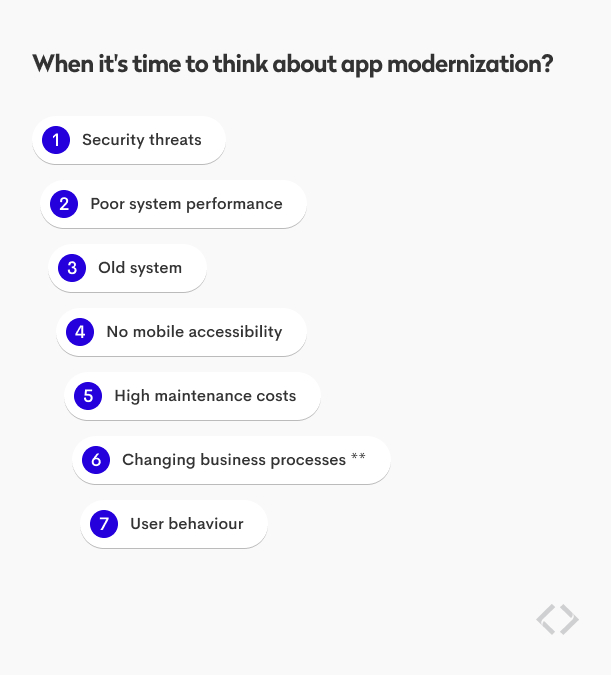Providing high-quality products and services helps to create trust between your business and your clients, and it should be maintained at every stage of your web app development process. Quality is also an essential element in the process of acquiring customers, meeting user expectations, and standing out from the competition. But how can application modernization help tailor a product to its customers’ expectations?
Many companies still use systems based on outdated technologies that negatively affect the quality of their product. Legacy applications are not flexible, may be slow, tend to crash, and come with an increased risk of data leakage and a lack of functionalities that meet current user needs. All of these generate additional costs and make it difficult to achieve business goals.
Adapting outdated systems to current trends can be difficult and expensive, so it’s worth focusing on software modernization, which can improve an app’s performance and allow you to adapt to the needs of a constantly changing market. Just as important, it will contribute to future cost savings.
What is app modernization?
According to Gartner, a “legacy” application is a system that may be based on outdated technologies but is important for everyday operations. Such applications are often difficult to scale, develop, and adding changes and new functionalities is typically problematic. Therefore, it’s necessary to modernize them.
One Gartner surveys show that 45% of respondents state that app modernization is one of the top five IT projects, and 41% of respondents think that extending the capabilities of key applications is a common key priority.
Application modernization means updating or converting legacy software to extend the lifespan of the application. This allows the system to adapt to current technology trends, applications to be scaled, increases cost savings and productivity and provides opportunities for innovation. Through this process, applications can continue to meet the expectations of today’s users.
The software modernization process also increases IT security, because old technologies are much more exposed to data leaks.
When is it worthwhile to modernize an application?
What are the signs that an application is not keeping pace with technological changes and must be modernized?

1. Security threats
Outdated frameworks and software are one of the first signals indicating the need to modernize an application. Systems based on technology that is no longer supported are more vulnerable to attacks and leakage of sensitive data, as they no longer receive security patches. That means it’s no longer possible to upgrade outdated systems to meet current security standards.
2. Poor system performance
Frequent crashes or slow data processing are not only inconveniences for users, but also create losses for the company. The time employees have to spend on debugging generates extra costs, and the need to work with older technologies can cause increased rotation on the team.
3. Legacy system and old design
Even if your application is relatively new, it may require software modernization and changes to keep up with the requirements of a dynamically changing market. Unfortunately, many applications still rely on archaic infrastructures and legacy code. This results in no availability on mobile devices and/or a lack of responsiveness.
4. No mobile accessibility
The widespread use of smartphones and the constantly increasing competition in the market have forced companies to move to the mobile world. If your system doesn’t allow access to your apps from different devices, it’s only a matter of time before your number of users will shrink and, in the future, disappear altogether.
5. High maintenance costs
The main signal for change is when the cost of maintaining the application outweighs the benefits you achieve. Investing in an outdated system that can no longer be maintained results in huge losses. Modernizing your web applications, which leads to improved performance, will allow you to generate higher revenues.
6. Changing business processes
Naturally, as a business grows, its needs and business processes change. These changes are often connected with the need to expand the application and adjust it to the current requirements of the target group. A lack of necessary functionality makes the product lose its attractiveness, which contributes to higher costs and lower productivity.
7. User behavior
If you notice a decrease in app traffic and negative user feedback, it’s a sign the system needs changes. You need to eliminate bugs and errors that cause user dissatisfaction, check the system’s compatibility with popular services and other systems, or at least switch out an outdated design.
When carrying out simple tasks requires too much user time and effort, it frustrates them and they quit the application.
8. Lack of documentation
A lack of documentation signals problems and obstacles in the app development. It’s difficult to identify errors when you don’t know the dependencies between the different elements of the system. It’s also not that easy to find developers who are willing to work with systems based on old technologies. If the person responsible for developing the app is no longer on the team, it may be time to upgrade.
How to prepare for application modernization
Effective software modernization process requires a proper preparation. The more details you think through before starting the work, the smoother the software transformation process will be. Below you will find a list of tasks that will make product development easier.
1. Gather information about the system
It’s important to gather as much information about the system as possible. Detailed documentation and/or access to the person who has the most information about the application will be useful.
2. Technology selection
One of the most important jobs is to analyze the technology stack of the application in question to see if the programming language or frameworks used are still up to date and supported. The choice of technology should depend on the specifics of the product and allow you to build an efficient application. The main goal should be to run the application in an environment that provides a return on investment.
3. Gather information about users
The behavior of users says a lot about whether the application is doing its job. So, it’s important to collect the necessary information about the users of the system in one place. Determine how many users are using the application and how often they use it.
4. Analyze important data in the system history
It’s also necessary to collect information related to data leaks, crashes, or errors that may affect the entire infrastructure. Plus, analyze the planned changes.
5. Budgeting and business planning
Before app modernization, determine what needs you want the system to address. It’s essential to adapt the software to changing market conditions, technological capabilities, and customer needs. Identify which metrics should be used to determine success. Also, schedule regular system updates to avoid the need to modernize your new application in the future.
Application modernization: stay ahead of the competition
When done properly, modernizing your web applications will allow you to adapt them to ever-changing technology requirements and business needs. Today’s consumers are more demanding and have higher expectations than ever, and the pace of change in the IT market is not slowing down. That’s why providing users with the best solutions, regardless of changing technologies, is a must.
Do you want to modernize your software and improve business indicators? Are you wondering if your application needs changes? Contact us to learn how we can help you!



